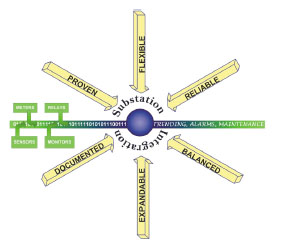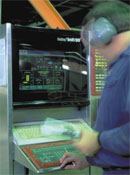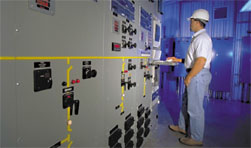
Remote monitoring of substation equipment is used to take advantage of present information technology to reduce operating costs while loading that equipment closer to nameplate ratings and deferring expenditures. The data obtained can be used for reliability centered maintenance programs that reduce maintenance costs. Remote monitoring systems have been around for so long that the original technology used is now found more in museums than in the field. While remote monitoring systems often create visions of Supervisory Control and Data Acquisition (SCADA) systems, a remote monitoring system can be as simple as connecting a remote device to a desktop computer for data acquisition without any control requirements. From the simplest system functionality to the most complex SCADA applications, a protocol is required to communicate with any remote device. The implication protocols have on simple system designs can pose significant challenges that can quickly add scope and costs to a project. Even a brief historical overview of protocols reveals some of the same challenges from years ago still exist and several guidelines are needed to help complete projects successfully.
The first remote monitoring systems often included communication equipment whose top speed was measured in baud, not in megabits per second as they are today. Hardware was designed and built by vendors who had a better solution than the other available protocols. Some utilities and industries even developed their own specialized protocol.
In 1978, Modbus was introduced as a simple but effective serial protocol. As the 1980s came and went, so did many industry protocols and hardware. Modbus was beginning to become a de facto industry standard despite it being a proprietary protocol. Meanwhile, utilities continued on a separate path from industry to improve and refine hardware and protocols. Utilities had a variety of protocols and hardware available to them from industry as well as from the utility industry. With so many protocols and devices, communications with devices from multiple vendors became difficult for utilities and industry. Buying a complete SCADA package that included remote terminal units simplified the problem, but with technology quickly advancing, the result years later included additional problems.
Many new initiatives started in the 1990s to address the problems. The Electrical Power Research Institute (EPRI) began a project to develop a single standard for utility communications based upon existing open standards, the Utility Communications Architecture (UCA‰). During this same period, the International Electrotechnical Commission (IEC) began work on developing a protocol for remote terminal units. The IEC work resulted in the IEC60870-5 standard. Additionally, the IEC work created a proprietary offshoot, the Distributed Networking Protocol (DNP), which to this day remains incompatible with IEC60870-5.


In 1993, GE Harris turned DNP over to the DNP User Group and it is still growing in popularity in North America. In 1995, IEC60870-5 was finalized and it is still gaining popularity in Europe and the Middle East. The DNP User Group has also issued recommended practices for using DNP over TCP/IP. By 1999, Schneider Electric published a Modbus transmission control protocol (TCP) specification that was no longer proprietary but an open protocol using the TCP and available for download from the Internet.
Work on UCA‰ continued as the new millennium began. Vendor, EPRI, utility, and other stakeholder involvement culminated in the UCA‰ Users Group and harmonization work with IEC61850. In industry, ControlNet International, the Industrial Ethernet Association and the Open DeviceNet Vendor Association announced EtherNet/IP, an industrial protocol (IP) using the Ethernet standard. Many vendors who once had a proprietary serial protocol starting bringing it to Ethernet in order to claim the openness of the Ethernet standard.
The culmination of this work on protocols reduced the number to a few dominant ones. However, the remaining protocols continue to overlap and are incompatible, but are now open standards or use open standards instead of being proprietary. The past decade of work should provide easier integration, where all devices could communicate and monitoring equipment would be “plug and play”. Even with a few protocols, a decision must be made regarding the best
application.
Today, the prospect of monitoring equipment in a substation, on a remote structure, or office can still be an overwhelming task. The pervasive nature of Ethernet and TCP/IP has begun to transform both industry and utilities with new protocols. Devices are beginning to support these new protocols in a form that can withstand the environmental rigors of the industrial and substation environment.
Even in the face of using open standards, simple monitoring of a single device using a proprietary serial protocol is still possible as vendors continue to support and develop proprietary protocols. However, as the number of devices from different vendors increases in combination with even a few protocol choices, serious integration issues begin to develop and threaten successful implementation.
Plugging in a device, attaching it to a computer and talking to it would seem easy. However, something as simple as the physical connection results in difficult issues such as cost-justification, data versus information, and security. What started out years ago as a serial connection using 300 baud modems on leased telephone lines has developed into power line carriers, microwave radios, VHF & UHF radios, multiple address radio systems, spread spectrum radios, fiber optics, and satellite communication. Each connection has benefits and problems that must be addressed for each application. For example, fiber optic cable provides huge bandwidth and noise immunity that is attractive for utilities who are now requiring millisecond update times for thousands of data points from dozens of devices. This replaces update times in seconds for hundreds of points from a single remote terminal unit. The installation cost of fiber optic cable can be difficult to justify for some utilities when the fiber is only used for protective relay and SCADA communications. Utilities are now installing fiber optic backbones and leasing the leftover bandwidth, resulting in a better return on investment.
In addition to the bandwidth provided by fiber optic systems, new intelligent electronic devices provide an ever-increasing number of data points and new SCADA systems can handle more data.
Operators can be deluged with data when they really need better information. Transforming data into information can be accomplished by analyzing data and sending information back to SCADA. By utilizing another communication path for volumes of data, operators can see the important information while the remaining data can be sent back to the enterprise to be accessed offline, near real-time by powerful database engines specifically built for crunching large amounts of data as well as time-ordered data.
It is possible for utilities to nearly connect everything and everyone to collect massive amounts of data by installing fiber optic cable on transmission and distribution lines past substations, customer meters, switches, capacitor banks, regulators, fault detectors, distributed generation, generators, and other devices. While power system operators, engineers and managers line up behind this prospect, also lining up are the corporate information technology personnel who normally operate, plan, and maintain the corporate network. Many times, the only contact these groups have had with each other is in the maintenance of employee computers. New discussions regarding leasing bandwidth, corporate network architecture, security, and dedicated fibers begin to emerge within a new corporate relationship.
While in the process of connecting devices and customers, network security becomes more significant than in the days of Y2K. In the past, the security of serial communications to remote devices was derived from the use of proprietary protocols by a monopoly. Combine deregulation with open standards and there is a potential financial gold mine of information available from unsecured communications with remote devices. This new security threat is now more tangible
from both inside and outside the utility. While many different security threats exist, even basic security management can mitigate many security risks. The simplest and most effective policy is the use of arbitrary and unique passwords for each device, but implementing this policy can be difficult due to internal culture.
Once the connection has been made, system design should be easy. However, an Ethernet connection means that DNP TCP/IP, Modbus TCP, EtherNet/IP, and UCA‰ could be used, as well as any other protocol that has been encapsulated into a TCP/IP frame and broadcast over Ethernet. Now the cables are standard because of Ethernet, but the protocols can still be different. Other system design issues abound. Will that corporate fiber optic network go to each location where you want a device? Does data from that new device need to go back to a legacy SCADA system? Can a connection be made to the existing remote monitoring system? When will the legacy SCADA system be replaced? What about other legacy devices already connected?
Substation integration brings together all of the intelligent electronic devices in a substation, which results in lower installation and maintenance costs while providing the means for collecting massive amounts of data that may be transformed to information at the substation and corporate level. Integration usually results in using the fewest protocols supported by the most devices in the system. Several guidelines for integrating substation devices can help lead to successfully monitoring remote devices.
The system must be flexible enough to incorporate new technologies. Flexibility has a direct relationship to “open” and “proprietary” systems. "Open" systems can give the impression that the system is flexible. However, many systems that are "open" may actually be "proprietary" systems that are de-facto standards or just widely used. Flexibility may also include the vendor who provides new products or new capabilities for products that follow or anticipate industry and utility trends. Flexibility with the new is good, but support of legacy devices can help make the transition from old to new easier.
System expansion must be possible and simple. Substations rarely start at the ultimate design. Adding a new device to the monitoring system for a new breaker, a new transformer, or other equipment is usually expected. Modular and distributed system designs make system expansion inherent by design. However, simplicity is relative as hardware and software contain issues that can quickly turn a simple design into a deceptively complex system.
The system must be reliable so data and control is provided when required. While many typical devices communicate at 9600 baud, many Ethernet devices support 10 MB and 100 MB – with gigabit approaching quickly. These speeds can mitigate many communication issues so data and control is provided as required. However, these speeds can not entirely account for poor network design that can overload an Ethernet network or create a communication bottleneck. Data and control can be provided via software or hardware, but network design can quickly make control times unpredictable and data update times longer than required.
Useful information in the system must be balanced while maximizing maintainability and manageability. Substation integration is a balancing act between software and hardware. Does software have an undocumented feature, or a feature that no one would use? If certain hardware is required, what software can be used to enhance the device? Often, system requirements include some system functions that drive up system cost while not providing a more manageable or maintainable system.
Proven equipment from vendors who have strong customer support is necessary. This means it has been successfully tested to applicable standards. Even finding agreement on what standards apply to a system can be a difficult task. Without strong customer support, even the best-proven equipment can turn into the least-used equipment. With strong customer support, even new equipment can turn into proven equipment.
The system must be well documented. Integration systems combine devices from multiple vendors and provide incredible system functionality with tremendous amounts of data. Traditional methods of documentation, like assembling device manuals, are typically inadequate and more detailed documentation is required in order to address the complete system functionality. While this kind of documentation is expensive and updates can become a substantial task, it can provide effective system training and reduce maintenance and troubleshooting costs.
Substation integration provides techniques for addressing the remote monitoring of substation equipment. However, issues that were raised thirty years ago still exist today. While the adoption of new communication protocol standards provide a promising future, vendors, utilities, consultants and industry must still work together to provide the communication architecture that allows the flexibility for creative differences within a standard framework.
CRAIG PREUSS is a substation integration project engineer for the Black & Veatch Corporation in Lake Oswego, Ore. He received his BS from Valparaiso University in Valparaiso, Ind. and his MSEE in power systems from the Illinois Institute of Technology in Chicago, Ill. He is a registered professional engineer in Ill. and Wash.







